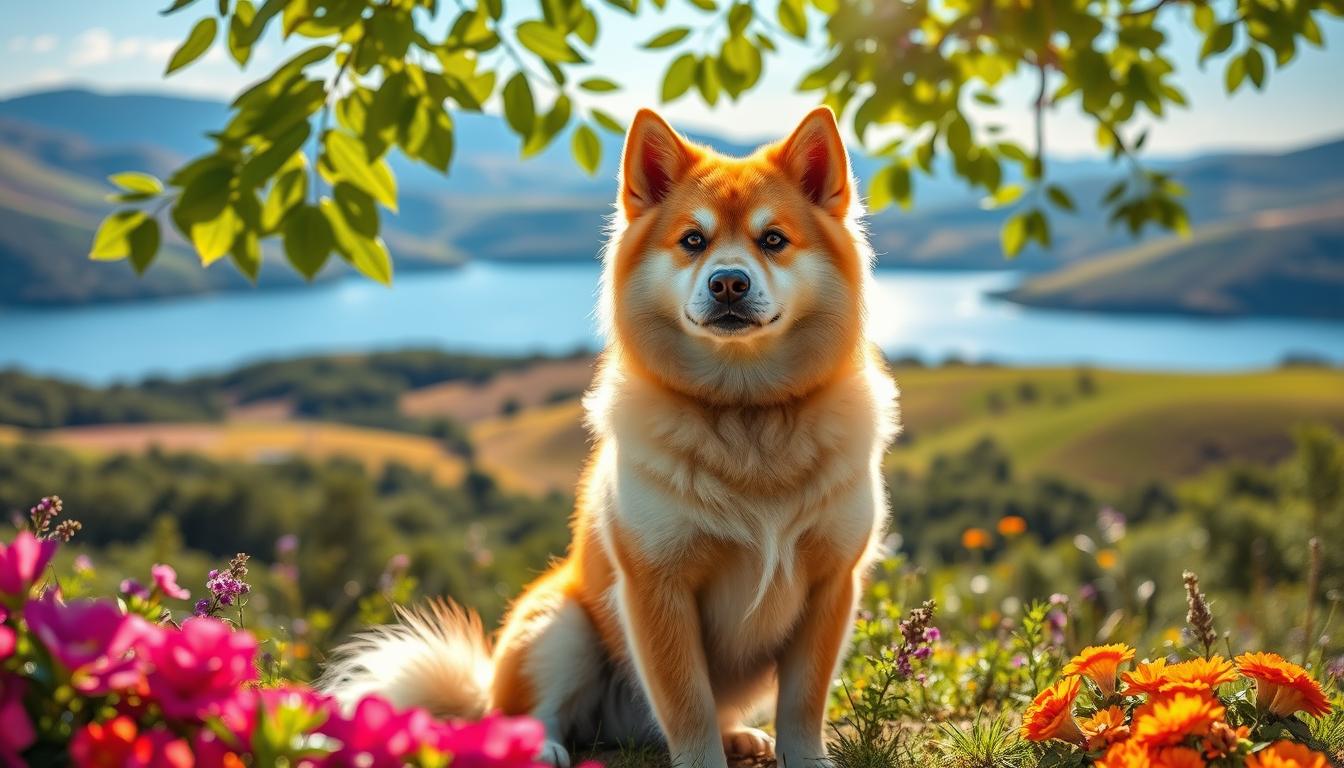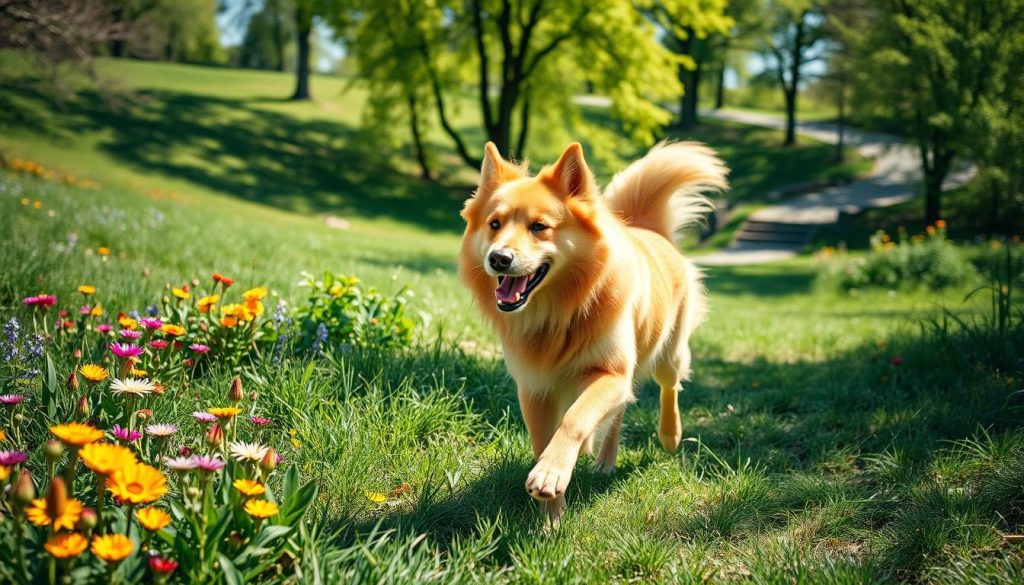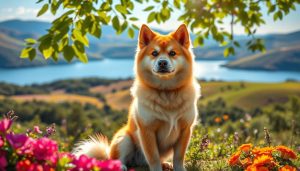Did you know the Shiba Inu, a close cousin to the Golden Inu, is pretty small? It stands between 13.5 to 16.5 inches at the shoulder and can weigh up to 23 pounds1. These numbers show us the sturdy yet compact nature of the Golden Inu. Welcome to your full guide on the Golden Inu. Here, we dive into the world of these kind and loyal friends. Whether you’re thinking of adding a Golden Inu to your home or just love their unique features, this guide provides important details. You will learn about their care, training, and overall health.
Key Takeaways
- Golden Inu dogs are known for their affectionate nature and loyalty.
- Physically, they are similar to the Shiba Inu, standing between 13.5 to 16.5 inches at the shoulder1.
- With the right care, they typically live between 12 to 15 years1.
- Good training and early social life are key for these independent but friendly dogs to get along with others1.
- Learn about the Golden Inu’s specific needs, from grooming to health care, for a joyful and healthy life.
Thinking of getting a Golden Inu or just interested in them? Let’s dive into the charm and unique aspects of this amazing breed together. Prepare to *discover golden inu* and all its beauty.
Introduction to the Golden Inu
The Golden Inu is more than just a dog breed. It stands as a symbol of loyalty with a deep history. This history links ancient Japan to our modern world. Learning about the Golden Inu’s beginnings and the breed’s details can deepen your affection for these lovely dogs.
Origin and History
The Golden Inu comes from Japan, originally bred for hunting. These dogs are known for their speed, smarts, and teamwork with humans. They nearly vanished but bounced back, becoming a favorite pet worldwide. The inu breed’s story shows us their power and kindness. They have been our close friends for ages, beyond just being hunters.
Popularity and Demand
Internet memes, like the ‘Doge’, made the Golden Inu very popular. This fame boosted their role as family pets. They charm people all over with their fox-like looks and lively spirit. Their lovely nature keeps them in high demand.
The Golden Inu community is all about working together and staying active. It includes many activities and platforms for its members2. There’s a group called Decentralized Autonomous Organization (DAO) that lets members help the community grow2. This way, the breed’s heritage and culture keep thriving.
Golden Inu Characteristics
The Golden Inu stands out with its fox-like looks, from its pointy triangular ears to its fluffy tail. These features make the breed very special and easy to recognize.
Physical Traits
The typical Golden Inu is about 13.5 to 16.5 inches tall and weighs around 17 to 23 pounds. They have a strong, muscular body under a soft, straight double coat. Their build shows they’re strong and quick, great for people or families who are always on the go.
Temperament
Golden Inus shine with their independence, loyalty, and watchful nature. These traits make them wonderful pets, as they’re both loving and protective. They do well on their own for a bit but best fit active homes where they can keep an eye on things.
Golden Inu vs Golden Retriever Inu
Choosing between a Golden Inu and a Golden Retriever Inu involves many factors. We need to look at their size, temperament, and how much care they need. The Golden Retriever Inu is a mix of the independent Shiba Inu and the friendly Golden Retriever. This gives you a pet that fits well in families and adapts easily.
The amount of exercise and care they need is a big difference between them. The Golden Retriever Inu needs lots of exercise. They like a 1.5-hour walk in the morning without a leash and an hour with a leash in the afternoon3. They also enjoy 30 minutes of fun games once or twice every day3.
On the other hand, Golden Inus like to do things on their own and don’t need as much exercise or attention. Yet, both types have similar fur colors and shed about the same. Their fur can be very light cream or deep red4.
| Criteria | Golden Inu | Golden Retriever Inu |
|---|---|---|
| Exercise Needs | Moderate | High: 1.5 hrs off-lead + 1 hr on-lead walks daily3 |
| Temperament | Independent | Friendly and trainable4 |
| Coat Colors | Pale cream to fox red | Pale cream to fox red4 |
When thinking about social behavior, there’s a noticeable difference. Golden Retrievers, especially the ones shown in competitions, love attention in public places3. This shows that Golden Retriever Inus are very social, while Golden Inus might be more shy.
Knowing how they act is also key to making your choice. Golden Retrievers think before jumping into new adventures4. But Golden Inus have a bold independence, thanks to their Shiba Inu roots.
At the end, your decision should match your lifestyle and what you want in a pet. Whether you want a pet that loves being with people or one that’s more laid-back, choose wisely. This will make sure you and your new pet are happy together.
How to Care for a Golden Inu
To take care of a Golden Inu, you need to focus on their grooming and diet. These tips will help keep your Golden Inu healthy and joyful.
Grooming Needs
Golden Inus require regular grooming to keep their coat and skin healthy. Brush their fur often to avoid tangles and lessen shedding. Aim to brush them several times a week.
Bathing them now and then helps maintain clean skin. Nail trimming is vital to prevent discomfort and injuries. Make sure to also keep their ears clean and teeth brushed to stop infections and maintain dental health. Grooming plays a big role in your Golden Inu’s health5.
Feeding Recommendations
A healthy diet is crucial for your Golden Inu’s well-being. Feed them high-quality dog food that fits their age group. A balanced diet boosts their energy, fur, and health. A vet can help customize their diet precisely.
Visiting the vet regularly provides advice on the proper food and how much to feed them. Their dietary needs can change, so it’s important to keep track. These steps will ensure your Golden Inu stays in great shape6.
Training Your Golden Inu
Training a Golden Inu requires patience and consistency. These smart dogs do well with a clear structure and positive praise. Setting boundaries and routines early on helps create a well-behaved pet.
Basic Commands
It’s key to teach your Golden Inu basic commands. Begin with “sit,” “stay,” and “come” during the Angel Phase (2-6 months). This time is crucial for learning obedience7. Use short, fun training sessions because their attention span is short at this age7. Being consistent sets clear rules for your dog.
Behavioral Tips
To live happily with your Golden Inu, understanding their behavior is important. Listen to their sounds like whining and barking to train them effectively7. Remember, they can get health issues like hip dysplasia and obesity, so plan exercise carefully8.
Use group training during their fear stages to help them overcome fears and avoid bad habits7. Create daily routines and rules for a structured life, leading to better behavior.
| Age | Training Focus | Health Considerations |
|---|---|---|
| 2-6 Months | Basic Commands | Short Attention Span |
| 6-18 Months | Group Training | Growth Monitoring |
| 18-24 Months | Advanced Training | Weight Management |
Health and Well-being of Golden Inu
The health and well-being of a Golden Inu are crucial. They live between 12 to 15 years but can get certain health problems. Paying close attention to their health issues and preventive care is key.
Common Health Issues
Golden Inus may face allergies, hip dysplasia, and patellar luxation. These issues are often inherited and need early detection. Regular vet visits are vital to promptly manage these health challenges.
It’s also important to know that some might have eye issues like cataracts and PRA. Catching these conditions early helps keep your dog healthy.
Preventive Care
Preventive care is essential for your Golden Inu’s health. It includes vaccinations, dental care, parasite control, and the right diet. About 80% of dog articles highlight the importance of regular health check-ups9. A balanced diet helps prevent obesity and health issues.
Start preventive care early to keep your Golden Inu healthy. Using these steps everyday makes for a happier pet. For more on dog well-being, check out resources and articles on pet care sites health check-ups for dogs.
Best Inu Breed Traits
Looking into the best inu breed traits, you’ll see the Golden Inu shines. It mixes the Shiba Inu’s personality beautifully. This mix gives them a smart and watchful nature. It makes them great guards and intelligent friends1011. They’re playful but dignified, fitting into many homes and lives easily.
They are very loyal to their owners, making them protective and dependable, especially when it’s needed11. Unlike many dogs, they don’t bark much. Instead, they communicate with howls, yodels, and growls11. This makes them charming companions without being too noisy.
These dogs are social and energetic. They get along with other friendly dogs like Akitas, Golden Retrievers, and Corgis10. Even though they can be aloof, they adapt well and can live with other pets when introduced properly10.
Finally, their long lifespan of 12-15 years means they’ll be with your family for a long time12. Keeping them mentally and physically active is key. Whether you want an independent friend or a versatile family pet, the Golden Inu is an excellent choice with its unique Shiba Inu traits.
How to Choose a Golden Inu Puppy
When picking a Golden Inu puppy, it’s important to be careful and thoughtful. You want to make sure your new friend is healthy and happy. Look for breeders who care deeply about their dogs. They should follow the best methods in breeding and raising their puppies.
Finding Reputable Breeders
Look for breeders who choose dogs with a history of health and good temperament. These breeders are likely to have puppies that are well-behaved and healthy13. A reputable breeder’s history includes working with dogs in competitions. Their puppies are often great for various dog activities13.
Good breeders produce puppies from working parents. These parents have records of performance and health13. They also start socializing their puppies early13. Plus, they help new owners succeed with their puppies13.
What to Look For
When choosing a puppy, look at their health and physical traits. They’re usually ready to join a new home at about 8 weeks old14. Pay attention to the puppy’s shoulders and neck. Watch how their back and front legs move together14.
Check the puppy’s head, eyes, ears, bite, and teeth for any problems14. Meeting the puppy in a calm place can make bonding easier15. Some breeders may let you spend a week with the puppy to see if it fits with your pets15. Being consistent and fair with all your pets is key to living together happily15.
Choosing carefully and paying close attention to the puppy you pick will help you find a Golden Inu that becomes a loved part of your family.
Golden Inu in Pop Culture
The Golden Inu’s role in pop culture is huge. This breed has found a special place, especially in the online world. Its charm goes far beyond just pet lovers.
An Internet Sensation
The Golden Inu became famous partly due to the doge meme. This meme is known for its funny texts over pictures of the Shiba Inu. Even though it features the Shiba Inu, all Inu breeds, like the Golden Inu, gained fame. The legend of Inu breeds in Japan shows them as loyal friends and protectors16.
Influence on Dog Memes
Memes about doge and Inu breeds are a big deal in culture. These memes are not just funny; they’ve changed the meme coin market. Golden Inu and DogeMiyagi use pop culture to get more fans. DogeMiyagi connects to “The Karate Kid” for a unique place in meme coins16. Big players like Dogecoin (DOGE) and Shiba Inu (SHIB) show the growing meme coin interest with their large market values17.
The Golden Inu is also part of the Golden Inuverse game. This play-to-earn game encourages players to explore, fight, trade, and win prizes. It helps build a strong community around this breed16.
Here’s a short comparison of some major meme coins:
| Meme Coin | Market Capitalization | Price |
|---|---|---|
| Dogecoin (DOGE) | $21 billion | $0.14 |
| Shiba Inu (SHIB) | $13 billion | $0.00002275 |
| Floki Inu (FLOKI) | $1.6 billion | $0.0001704 |
| Bonk (BONK) | $1.5 billion | $0.00002384 |
The meme coin world keeps growing, showing the Golden Inu’s lasting appeal. It fits perfectly into today’s digital and cultural scenes.
Golden Inu Exercise Requirements
The Golden Inu needs regular exercise to stay healthy and alert. Daily walks and playful activities are key for their happiness and fitness.
Daily Walks
Golden Inus enjoy daily walks as part of their exercise. Young puppies are more active and need short, playful exercises18. They require at least an hour of activity every day19. The exercise time should match your dog’s age and energy. Puppies need roughly five minutes of activity for each month of age. Adult dogs usually need 1 to 2 hours a day20.
Interactive Play
Playing games is as important as exercise for Golden Inus. Games like fetch and tug of war keep their minds sharp. These activities help them feel good20. On rainy days, indoor games and agility training are great options18. Dog sports such as AKC Agility and Flyball offer fun ways to stay active18.
Regular walks and fun games keep your Golden Inu joyful and healthy. This mix of activities ensures they get enough exercise.
Nutritional Needs of Golden Inu
Taking care of your Golden Inu’s health means knowing what they should eat. Their diet needs the right mix of protein, fats, and carbs. This mix varies with their age, size, and how active they are. You can meet these needs with good dog food or home-cooked meals that a vet approves. Yet, it’s important to watch the salt in foods for older dogs. Too much or too little salt can harm their heart health21.
Diet Essentials
Protein is key in a Golden Inu’s diet. Experts say older, healthy dogs need foods with 28% to 32% protein. Older dogs might even need 50% more protein to keep their muscles strong21. The amount of phosphorus in their food also matters. This can greatly impact dogs with kidney issues21. When it comes to how much to feed, 2-3% of the dog’s body weight in ounces is a good rule22. Some suggest fresh food over kibble for more nutrients23.
Treat Recommendations
Picking the right treats for your Inu is important23. Treats should be healthy but not given too often to prevent weight gain. Huntaway’s raw dog food, in 3-ounce cubes, is great if thawed for 12 hours and eaten within 30 minutes22. Look for treats with Omega-3 fats, which help with joint and brain health in old dogs. The advised amount is between 700 to 1,500 mg21. Be sure to keep their total calories in check to avoid overfeeding.
Socializing Your Golden Inu
Teaching your Golden Inu to be friendly and well-behaved starts early. It’s important to get them used to different places, people, and animals. This way, they learn to be confident and positive around others.
Early Socialization Techniques
Early on, it’s key to introduce your Golden Inu puppy to the world. Show them new places, meet new people, and have them play with other dogs. Keeping track of these encounters can help you ensure a well-rounded pup24.
Dog parks might seem good for socializing, but they can be too wild and risky24. Better options include dog training classes, playgroups, one-on-one playdates, and open park hikes24.
Introducing to Other Pets
When bringing a new pet into the mix, go slow and watch how they get along. Early positive meetings are crucial to avoid aggression later on25.
Puppies have fear periods at 8-10 weeks and again between 6-14 months. A bad experience during these times can impact them long-term25.
Creating a socialization plan tailored to your Golden Inu’s personality helps. Always be ready to step in if things don’t go well24.
To blend your Golden Inu with other pets, keep a close watch and introduce them slowly. Start by letting them get used to each other’s scent. Increasing their time together gently can help them get along better25.
Golden Inu Lifespan and Longevity
The golden inu’s lifespan is shaped by various elements, like genetics and lifestyle. Good care from owners improves their lives greatly. Knowing these can help your furry friend enjoy a longer, healthier life.
Factors Influencing Longevity
Genetics strongly affect how long dogs live. Research shows some genes add nearly two years to a dog’s life. Golden Retrievers with the HER4 gene variant live up to 13.5 years. This is longer than those without it26. Also, female dogs usually live longer than males27.
Dog size and breed matter too. Small breeds, like the Lancashire Heeler, often live longer than big breeds. For example, Lancashire Heelers can reach 15.4 years, much longer than Rottweilers, who live around 8 years2827. Crossbred dogs also tend to outlive purebreds, by about 1.2-1.3 years, thanks to mixed genes27.
Tips for a Healthy Life
To help your Golden Inu live longer, regular vet visits are key. They can spot health problems early. A balanced diet is also crucial for preventing health issues. Especially for Golden Inus with longevity-related gene variants26.
Exercise is important too. Golden Inus need physical activity to keep fit and avoid diseases. Play and daily walks benefit their body and mind.
Lastly, a loving home matters a lot. Dogs sense their environment’s mood. A caring home improves their life quality. Watching for changes in behavior or health is vital for their wellbeing.
| Breed | Average Lifespan (years) |
|---|---|
| Lancashire Heeler | 15.4 |
| Tibetan Spaniel | 15.2 |
| Bolognese | 14.9 |
| Shiba Inu | 14.6 |
| Bulldogs | 9.8 |
| West Highland White Terriers | 12.7-13.5 |
| Golden Retrievers with HER4 variant | 13.5 |
| Golden Retrievers without HER4 variant | 11.6 |
| Rottweilers | 8.0-8.4 |
Why Golden Inu Might be the Right Dog for You
The Golden Inu is great for many families because it is adaptable and friendly. It fits well in various homes, which makes it a top pick for those wanting a dog that matches family life and can live anywhere.
Family Compatibility
The Golden Inu is known for being gentle and patient, especially with kids. This creates a peaceful home29. They also get along with other pets, thanks to being socialized early on29. Their social and welcoming nature means they make friends quickly, adding fun to family events29.
Living Arrangements
The Golden Inu does well in both apartments and houses with yards. They are happiest with daily exercise, which keeps them well-behaved29. Even in small spaces, they’re calm and don’t bark much, making them great company29. They are loyal and their need for moderate exercise means they adjust easily to your lifestyle, whether that involves running, hiking, or playing at home29.
The Golden Inu is not just a pet, but a loyal friend for any household. They easily fit into various family setups, bringing joy to all.
Conclusion
The Golden Inu breed guide highlights the unique qualities of these dogs. They are not just pets but loyal friends and family members. This guide has covered everything you need to know to care for your Golden Inu. It helps you create a loving environment for them.
Choosing a Golden Inu means picking a dog with historic and modern charms. They blend intelligence, loyalty, and fun perfectly. They fit well in many homes and families. Their health, grooming, and diet are also key for a long, joyful life together. To learn more, check out this resource.
The Golden Inu offers an enriching experience that adds to your life. With this guide, you’re ready to form a deep, loving bond with your Golden Inu. Everyday will be full of happiness and companionship. Remember, a life with a Golden Inu is rewarding. It brings you closer to a centuries-old legacy303132.









